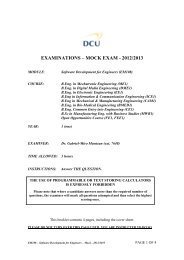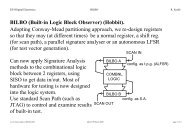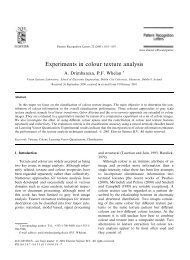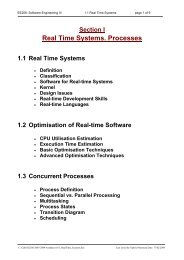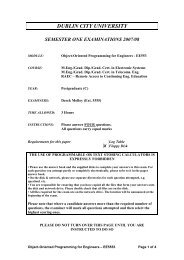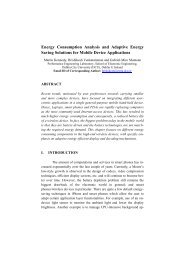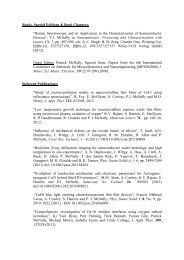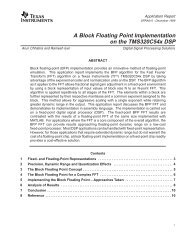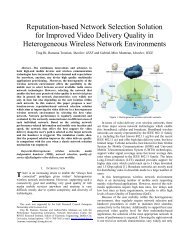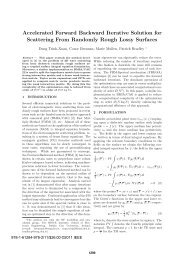High Intensity, Double Heterojunction AlGaAs Red LED Lamps
High Intensity, Double Heterojunction AlGaAs Red LED Lamps
High Intensity, Double Heterojunction AlGaAs Red LED Lamps
- No tags were found...
Create successful ePaper yourself
Turn your PDF publications into a flip-book with our unique Google optimized e-Paper software.
AgilentT-1 3 / 4 (5 mm), T-1 (3 mm),<strong>High</strong> <strong>Intensity</strong>, <strong>Double</strong> <strong>Heterojunction</strong><strong>AlGaAs</strong> <strong>Red</strong> <strong>LED</strong> <strong>Lamps</strong>Data SheetHLMP-D101/D105, HLMP-K101/K105DescriptionThese solid state <strong>LED</strong> lamps utilizenewly developed doubleheterojunction (DH) <strong>AlGaAs</strong>/GaAsmaterial technology. This <strong>LED</strong>material has outstanding lightoutput efficiency over a wide rangePackage Dimensionsof drive currents. The color isdeep red at the dominantwavelength of 637 nanometres.These lamps may be DC or pulsedriven to achieve desired lightoutput.Features• Exceptional brightness• Wide viewing angle• Outstanding material efficiency• Low forward voltage• CMOS/MOS compatible• TTL compatible• Deep red colorApplications• Bright ambient lighting conditions• Moving message panels• Portable equipment• General use3.17 (0.125)∅2.67 (0.105)3.43 (0.135)2.92 (0.115)4.70 (0.185)6.35 (0.250)4.19 (0.165)5.58 (0.220)1.14 (0.045)0.51 (0.020)SHOULDER24.1(0.95) MIN.0.65 (0.026) MAX.CATHODE0.55 (0.022)SQ. TYP.0.40 (0.016)1.52 (0.060)1.02 (0.040)2.79 (0.110)2.29 (0.090)CATHODEA B C
Selection GuideLuminous <strong>Intensity</strong>Iv (mcd) at 20 mA 2θ [1] 1/2 PackagePackage Description Device HLMP- Min. Typ. Max. Degree OutlineT-1 3/4 <strong>Red</strong> Tinted Diffused D101 35.2 70.0 – 65 AD101-J00xx 35.2 70.0 – 65 AD101-JK0xx 35.2 70.0 112.8 65 AT-1 3/4 <strong>Red</strong> Untinted Non-diffused D105 138.0 240.0 – 24 BD105-M00xx 138.0 240.0 – 24 BD105-NO0xx 200.0 290.0 580.0 24 BT-1 <strong>Red</strong> Tinted Diffused K101 22.0 45.0 – 60 CK101-100xx 22.0 45.0 – 60 CK101-IJ0xx 22.0 45.0 70.4 60 CT-1 <strong>Red</strong> Untinted Non-diffused K105 35.2 65.0 – 45 CK105-J00xx 35.2 65.0 – 45 CK105-KL0xx 56.4 110.0 180.4 45 CNote:1. θ 1/2 is the off axis angle from lamp centerline where the luminous intensity is 1 /2 the on-axis value.Part Numbering SystemHLMP - x x xx - x x x xxMechanical Option00: Bulk01: Tape & Reel, Crimped Leads02: Tape & Reel, Straight LeadsA1: Right Angle Housing, Uneven Leads, T1A2: Right Angle Housing, Even Leads, T1B1: Right Angle Housing, Uneven Leads, T-1 3/4B2: Right Angle Housing, Even Leads, T-1 3/4DD, UQ: Ammo PackColor Bin Options0: Full Color Bin DistributionMaximum Iv Bin Options0: Open (no max. limit)Others: Please refer to the Iv Bin TableMinimum Iv Bin OptionsPlease refer to the Iv Bin TableLens Type01: Tinted, Diffused05: Untinted, NondiffusedColor Options1: <strong>AlGaAs</strong> <strong>Red</strong>Package OptionsD: T-1 3/4K: T-12
Absolute Maximum Ratings at T A = 25°CParameterPeak Forward Current [1,2]Average Forward Current [2]DC Current [3]Power DissipationReverse Voltage (I R = 100 µA)Transient Forward Current (10 µs Pulse) [4]Value300 mA20 mA30 mA87 mW5 V500 mA<strong>LED</strong> Junction Temperature 110°COperating Temperature RangeStorage Temperature Range-20 to +100°C-55 to +100°CNotes:1. Maximum I PEAK at f = 1 kHz, DF = 6.7%.2. Refer to Figure 6 to establish pulsed operating conditions.3. Derate linearly as shown in Figure 5.4. The transient peak current is the maximum non-recurring peak current the device can withstand without damaging the <strong>LED</strong> die and wire bonds. It isnot recommended that the device be operated at peak currents beyond the Absolute Maximum Peak Forward Current.Electrical/Optical Characteristics at T A = 25°CSymbol Description Min. Typ. Max. Unit Test ConditionV F Forward Voltage 1.8 2.2 V I F = 20 mAV R Reverse Breakdown Voltage 5.0 15.0 V I R = 100 µAλ p Peak Wavelength 645 nm Measurement at Peakλ d Dominant Wavelength 637 nm Note 1∆λ 1 /2 Spectral Line Halfwidth 20 nmτ S Speed of Response 30 ns Exponential TimeConstant, e -t /T SC Capacitance 30 pF V F = 0, f = 1 MHzRθ J-PIN Thermal Resistance 260 [3] °C/W Junction to Cathode Lead210 [4]290 [5]η V Luminous Efficacy 80 Im/W Note 2Notes:1. The dominant wavelength, λ d , is derived from the CIE chromaticity diagram and represents the color of the device.2. The radiant intensity, I e , in watts per steradian, may be found from the equation I e = l V /η V , where I V is the luminous intensity in candelas and η V isluminous efficacy in lumens/watt.3. HLMP-D101.4. HLMP-D105.5. HLMP-K101/-K105.3
Figure 1. Relative intensity vs. wavelength.Figure 2. Forward current vs. forward voltage.Figure 3. Relative luminous intensity vs. dc forward current.Figure 4. Relative efficiency vs. peak forward current.Figure 5. Maximum forward dc current vs. ambient temperature.Derating based on T J MAX. = 110°C.Figure 6. Maximum tolerable peak current vs. peak duration (I PEAKMAX. determined from temperature derated I DC MAX.).4
Figure 7. Relative luminous intensity vs. angular displacement.HLMP-D101.Figure 8. Relative luminous intensity vs. angular displacement.HLMP-K101.Figure 9. Relative luminous intensity vs. angular displacement.HLMP-D105.Figure 10. Relative luminous intensity vs. angular displacement.HLMP-K105.5
<strong>Intensity</strong> Bin Limits<strong>Intensity</strong> Range (mcd)Color Bin Min. Max.<strong>Red</strong> I 24.8 39.6J 39.6 63.4K 63.4 101.5L 101.5 162.4M 162.4 234.6N 234.6 340.0O 340.0 540.0P 540.0 850.0Q 850.0 1200.0R 1200.0 1700.0S 1700.0 2400.0T 2400.0 3400.0U 3400.0 4900.0V 4900.0 7100.0W 7100.0 10200.0X 10200.0 14800.0Y 14800.0 21400.0Z 21400.0 30900.0Maximum tolerance for each bin limit is ± 18%.Mechanical Option MatrixMechanical Option Code Definition00 Bulk Packaging, minimum increment 500 pcs/bag01 Tape & Reel, crimped leads, minimum increment 1300 pcs (T-1 3/4)/1800 pcs (T-1)02 Tape & Reel, straight leads, minimum increment 1300 pcs (T-1 3/4)/1800 pcs (T-1)A1Right Angle Housing, uneven leads, minimum increment 500 pcs/bagA2Right Angle Housing, even leads, minimum increment 500 pcs/bagB1Right Angle Housing, uneven leads, minimum increment 500 pcs/bagB2Right Angle Housing, even leads, minimum increment 500 pcs/bagDDAmmo Pack, straight leads in 2K incrementUQAmmo Pack, horizontal leads in 2K incrementNote:All categories are established for classification of products. Products may not be available in all categories. Please contact your local Agilentrepresentative for further clarification/information.6
PrecautionsLead Forming• The leads of an <strong>LED</strong> lamp may be preformed or cut tolength prior to insertion and soldering into PC board.• If lead forming is required before soldering, care mustbe taken to avoid any excessive mechanical stressinduced to <strong>LED</strong> package. Otherwise, cut the leads of<strong>LED</strong> to length after soldering process at roomtemperature. The solder joint formed will absorb themechanical stress of the lead cutting from traveling tothe <strong>LED</strong> chip die attach and wirebond.• It is recommended that tooling made to preciselyform and cut the leads to length rather than rely uponhand operation.Soldering Conditions• Care must be taken during PCB assembly andsoldering process to prevent damage to <strong>LED</strong>component.• The closest <strong>LED</strong> is allowed to solder on board is 1.59mm below the body (encapsulant epoxy) for thoseparts without standoff.• Recommended soldering conditions:Manual SolderWave Soldering DippingPre-heat Temperature 105 °C Max. –Pre-heat Time 30 sec Max. –Peak Temperature 250 °C Max. 260 °C Max.Dwell Time 3 sec Max. 5 sec Max.• Wave soldering parameter must be set andmaintained according to recommended temperatureand dwell time in the solder wave. Customer isadvised to periodically check on the soldering profileto ensure the soldering profile used is alwaysconforming to recommended soldering condition.• If necessary, use fixture to hold the <strong>LED</strong> componentin proper orientation with respect to the PCB duringsoldering process.• Proper handling is imperative to avoid excessivethermal stresses to <strong>LED</strong> components when heated.Therefore, the soldered PCB must be allowed to coolto room temperature, 25°C, before handling.• Special attention must be given to board fabrication,solder masking, surface plating and lead holes sizeand component orientation to assure solderability.• Recommended PC board plated through hole sizes for<strong>LED</strong> component leads:<strong>LED</strong> ComponentPlated ThroughLead Size Diagonal Hole Diameter0.457 x 0.457 mm 0.646 mm 0.976 to 1.078 mm(0.018 x 0.018 inch) (0.025 inch) (0.038 to 0.042 inch)0.508 x 0.508 mm 0.718 mm 1.049 to 1.150 mm(0.020 x 0.020 inch) (0.028 inch) (0.041 to 0.045 inch)Note: Refer to application note AN1027 for moreinformation on soldering <strong>LED</strong> components.TEMPERATURE – °C2502001501005030TURBULENT WAVEFLUXINGPREHEATLAMINAR WAVEHOT AIR KNIFEBOTTOM SIDEOF PC BOARDTOP SIDE OFPC BOARDCONVEYOR SPEED = 1.83 M/MIN (6 FT/MIN)PREHEAT SETTING = 150°C (100°C PCB)SOLDER WAVE TEMPERATURE = 245°CAIR KNIFE AIR TEMPERATURE = 390°CAIR KNIFE DISTANCE = 1.91 mm (0.25 IN.)AIR KNIFE ANGLE = 40°SOLDER: SN63; FLUX: RMANOTE: ALLOW FOR BOARDS TO BESUFFICIENTLY COO<strong>LED</strong> BEFORE EXERTINGMECHANICAL FORCE.0 10 2030 40 50 60 70 80 90 100TIME – SECONDSFigure 11. Recommended wave soldering profile.7
www.agilent.com/semiconductorsFor product information and a complete list ofdistributors, please go to our web site.For technical assistance call:Americas/Canada: +1 (800) 235-0312 or(916) 788-6763Europe: +49 (0) 6441 92460China: 10800 650 0017Hong Kong: (+65) 6756 2394India, Australia, New Zealand: (+65) 6755 1939Japan: (+81 3) 3335-8152 (Domestic/International),or 0120-61-1280 (Domestic Only)Korea: (+65) 6755 1989Singapore, Malaysia, Vietnam, Thailand,Philippines, Indonesia: (+65) 6755 2044Taiwan: (+65) 6755 1843Data subject to change.Copyright © 2004-2005 Agilent Technologies, Inc.Obsoletes 5988-2230ENNovember 12, 20055989-4250EN



